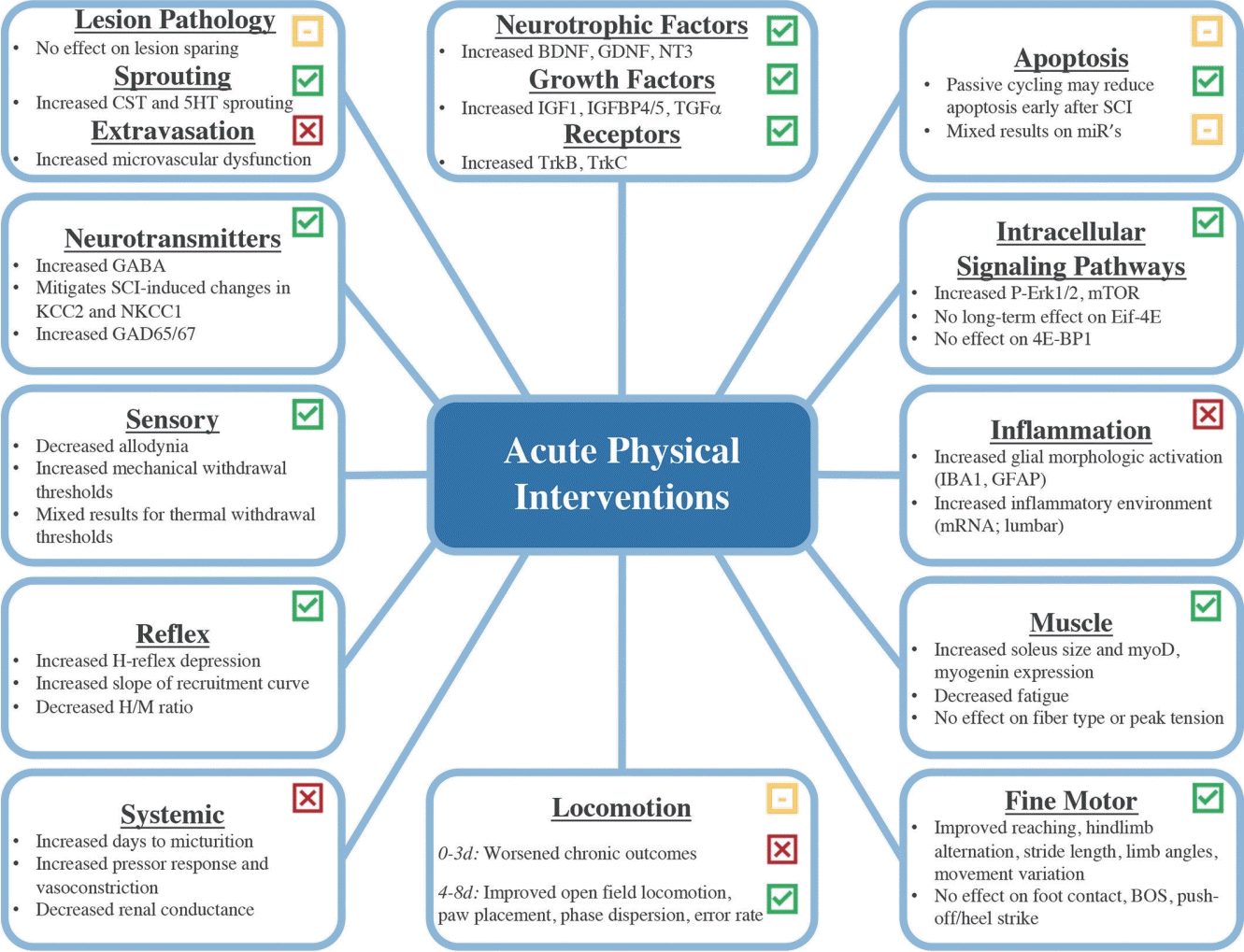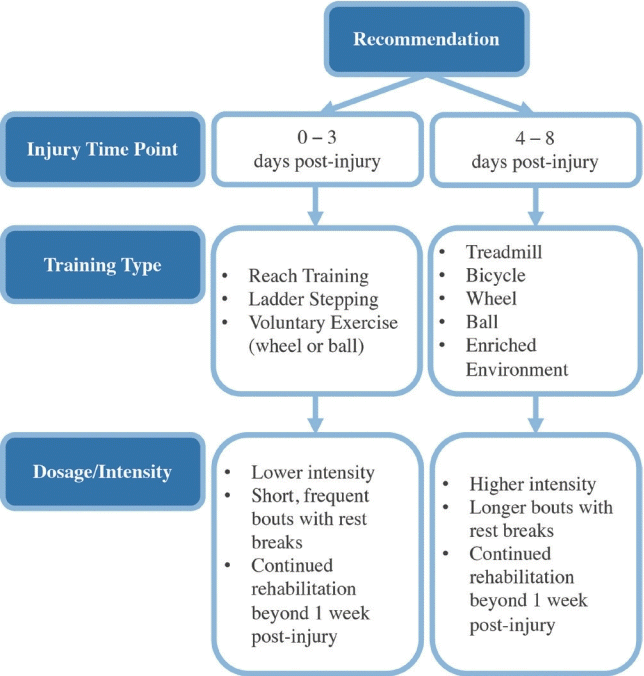3. Kwon BK. Optimizing hemodynamic support of acute spinal cord injury based on injury mechanism. Annual rept. 30 Sep 2014-29 Sep 2015; Fort Belvoir (VA): Defense Technical Information Center. 2015.
4. Squair JW, Bélanger LM, Tsang A, et al. Empirical targets for acute hemodynamic management of individuals with spinal cord injury. Neurology 2019 93:e1205-11.


6. Garcia-Alias G, Barkhuysen S, Buckle M, et al. Chondroitinase ABC treatment opens a window of opportunity for taskspecific rehabilitation. Nat Neurosci 2009 12:1145-51.


8. Bunge MB, Wood PM. Realizing the maximum potential of Schwann cells to promote recovery from spinal cord injury. Handb Clin Neurol 2012 109:523-40.


10. Shinozaki M, Iwanami A, Fujiyoshi K, et al. Combined treatment with chondroitinase ABC and treadmill rehabilitation for chronic severe spinal cord injury in adult rats. Neurosci Res 2016 113:37-47.


12. Lebedev MA, Nicolelis MA. Brain-machine interfaces: from basic science to neuroprostheses and neurorehabilitation. Physiol Rev 2017 97:767-837.


13. Angeli CA, Boakye M, Morton RA, et al. Recovery of overground walking after chronic motor complete spinal cord injury. N Engl J Med 2018 379:1244-50.


14. Gill ML, Grahn PJ, Calvert JS, et al. Neuromodulation of lumbosacral spinal networks enables independent stepping after complete paraplegia. Nat Med 2018 24:1677-82.


15. Wagner FB, Mignardot JB, Le Goff-Mignardot CG, et al. Targeted neurotechnology restores walking in humans with spinal cord injury. Nature 2018 563:65-71.


18. DeJong G, Tian W, Hsieh CH, et al. Rehospitalization in the first year of traumatic spinal cord injury after discharge from medical rehabilitation. Arch Phys Med Rehabil 2013 94(4 Suppl 2):S87-97.


19. National Spinal Cord Injury Statistical Center. Spinal cord injury facts and figures at a glance. Birmingham (AL): National Spinal Cord Injury Statistical Center; 2022.
20. Morrison SA, Lorenz D, Eskay CP, et al. Longitudinal recovery and reduced costs after 120 sessions of locomotor training for motor incomplete spinal cord injury. Arch Phys Med Rehabil 2018 99:555-62.


21. Goulet J, Richard-Denis A, Thompson C, et al. Relationships between specific functional abilities and health-related quality of life in chronic traumatic spinal cord injury. Am J Phys Med Rehabil 2019 98:14-9.


22. Kleim JA, Jones TA. Principles of experience-dependent neural plasticity: implications for rehabilitation after brain damage. J Speech Lang Hear Res 2008 51:S225-39.


23. Behrman AL, Bowden MG, Nair PM. Neuroplasticity after spinal cord injury and training: an emerging paradigm shift in rehabilitation and walking recovery. Physical Therapy 2006 86:1406-25.


24. Sadowsky CL, McDonald JW. Activity-based restorative therapies: concepts and applications in spinal cord injury-related neurorehabilitation. Dev Disabil Res Rev 2009 15:112-6.


25. Field-Fote EC. Spinal cord injury rehabilitation. Philadelphia (PA): FA Davis; 2009.
26. Fouad K, Tetzlaff W. Rehabilitative training and plasticity following spinal cord injury. Exp Neurol 2012 235:91-9.


28. Beauparlant J, van den Brand R, Barraud Q, et al. Undirected compensatory plasticity contributes to neuronal dysfunction after severe spinal cord injury. Brain 2013 136(Pt 11):3347-61.


29. Takeoka A, Vollenweider I, Courtine G, et al. Muscle spindle feedback directs locomotor recovery and circuit reorganization after spinal cord injury. Cell 2014 159:1626-39.


30. Ichiyama R, Maier IC, Schnell L, et al. Nogo-A antibody treatment and locomotor training after an incomplete spinal cord injury result in improved locomotor recovery. Neuroscience Meeting Planner. San Diego (CA): Society for Neuroscience; 2007.
31. Maier IC, Ichiyama RM, Courtine G, et al. Differential effects of anti-Nogo-A antibody treatment and treadmill training in rats with incomplete spinal cord injury. Brain 2009 132:1426-40.


33. Buehner JJ, Forrest GF, Schmidt-Read M, et al. Relationship between ASIA examination and functional outcomes in the NeuroRecovery Network locomotor training program. Arch Phys Med Rehabil 2012 93:1530-40.


34. Quel de Oliveira C, Refshauge K, Middleton J, et al. Effects of activity-based therapy interventions on mobility, independence, and quality of life for people with spinal cord injuries: a systematic review and meta-analysis. J Neurotrauma 2017 34:1726-43.


35. Mehrholz J, Kugler J, Pohl M. Locomotor training for walking after spinal cord injury. Cochrane Database Syst Rev 2012 11:CD006676.


36. Engesser-Cesar C, Anderson AJ, Basso DM, et al. Voluntary wheel running improves recovery from a moderate spinal cord injury. J Neurotrauma 2005 22:157-71.


38. Scivoletto G, Morganti B, Molinari M. Early versus delayed inpatient spinal cord injury rehabilitation: an Italian study. Arch Phys Med Rehabil 2005 86:512-6.


39. Krajacic A, Ghosh M, Puentes R, et al. Advantages of delaying the onset of rehabilitative reaching training in rats with incomplete spinal cord injury. Eur J Neurosci 2009 29:641-51.


40. Dupont-Versteegden EE, Houlé JD, Dennis RA, et al. Exercise-induced gene expression in soleus muscle is dependent on time after spinal cord injury in rats. Muscle Nerve 2004 29:73-81.


42. Griesbach GS, Gomez-Pinilla F, Hovda DA. The upregulation of plasticity-related proteins following TBI is disrupted with acute voluntary exercise. Brain Rese 2004 1016:154-62.

49. Loy K, Schmalz A, Hoche T, et al. Enhanced voluntary exercise improves functional recovery following spinal cord injury by impacting the local neuroglial injury response and supporting the rewiring of supraspinal circuits. J Neurotrauma 2018 35:2904-15.


50. Girgis J, Merrett D, Kirkland S, et al. Reaching training in rats with spinal cord injury promotes plasticity and task specific recovery. Brain 2007 130:2993-3003.


51. Hutchinson KJ, Gomez-Pinilla F, Crowe MJ, et al. Three exercise paradigms differentially improve sensory recovery after spinal cord contusion in rats. Brain 2004 127:1403-14.


52. Multon S, Franzen R, Poirrier AL, et al. The effect of treadmill training on motor recovery after a partial spinal cord compression-injury in the adult rat. J Neurotrauma 2003 20:699-706.


53. Krajacic A, Weishaupt N, Girgis J, et al. Training-induced plasticity in rats with cervical spinal cord injury: effects and side effects. Behav Brain Res 2010 214:323-31.


54. Norrie BA, Nevett-Duchcherer JM, Gorassini MA. Reduced functional recovery by delaying motor training after spinal cord injury. J Neurophysiol 2005 94:255-64.


55. Fouad K, Metz GA, Merkler D, et al. Treadmill training in incomplete spinal cord injured rats. Behav Brain Res 2000 115:107-13.


58. Alvarez-Mejia L, Morales J, Cruz GJ, et al. Functional recovery in spinal cord injured rats using polypyrrole/iodine implants and treadmill training. J Mater Sci Mater Med 2015 26:209.


64. Oh MJ, Seo TB, Kwon KB, et al. Axonal outgrowth and Erk1/2 activation by training after spinal cord injury in rats. J Neurotrauma 2009 26:2071-82.


65. van den Brand R, Heutschi J, Barraud Q, et al. Restoring voluntary control of locomotion after paralyzing spinal cord injury. Science 2012 336:1182-5.


66. Asboth L, Friedli L, Beauparlant J, et al. Cortico–reticulo–spinal circuit reorganization enables functional recovery after severe spinal cord contusion. Nat Neurosci 2018 21:576-88.


67. Endo T, Ajiki T, Inoue H, et al. Early exercise in spinal cord injured rats induces allodynia through TrkB signaling. Biochem Biophys Res Commun 2009 381:339-44.


68. Tashiro S, Shinozaki M, Mukaino M, et al. BDNF induced by treadmill training contributes to the suppression of spasticity and allodynia after spinal cord injury via upregulation of KCC2. Neurorehabil Neural Repair 2015 29:677-89.


69. Laird AS, Carrive P, Waite PM. Effect of treadmill training on autonomic dysreflexia in spinal cord--injured rats. Neurorehabil Neural Repair 2009 23:910-20.


70. West CR, Crawford MA, Laher I, et al. Passive hind-limb cycling reduces the severity of autonomic dysreflexia after experimental spinal cord injury. Neurorehabil Neural Repair 2016 30:317-27.


71. Wang H, Liu NK, Zhang YP, et al. Treadmill training induced lumbar motoneuron dendritic plasticity and behavior recovery in adult rats after a thoracic contusive spinal cord injury. Exp Neurol 2015 271:368-78.


72. Wang D, Fawcett J. The perineuronal net and the control of CNS plasticity. Cell Tissue Res 2012 349:147-60.


73. Sánchez-Ventura J, Giménez-Llort L, Penas C, et al. Voluntary wheel running preserves lumbar perineuronal nets, enhances motor functions and prevents hyperreflexia after spinal cord injury. Exp Neurol 2021 336:113533.


75. Goldshmit Y, Lythgo N, Galea MP, et al. Treadmill training after spinal cord hemisection in mice promotes axonal sprouting and synapse formation and improves motor recovery. J Neurotrauma 2008 25:449-65.


76. Hou J, Nelson R, Nissim N, et al. Effect of combined treadmill training and magnetic stimulation on spasticity and gait impairments after cervical spinal cord injury. J Neurotrauma 2014 31:1088-106.


80. Ying Z, Roy RR, Edgerton VR, et al. Exercise restores levels of neurotrophins and synaptic plasticity following spinal cord injury. Exp Neurol 2005 193:411-9.


83. Sun T, Ye C, Wu J, et al. Treadmill step training promotes spinal cord neural plasticity after incomplete spinal cord injury. Neural Regen Res 2013 8:2540-7.


86. Goldstein EZ, Church JS, Hesp ZC, et al. A silver lining of neuroinflammation: Beneficial effects on myelination. Exp Neurol 2016 283:550-9.


88. Bethea JR. Spinal cord injury-induced inflammation: a dualedged sword. Prog Brain Res 2000 128:33-42.


89. Gensel JC, Zhang B. Macrophage activation and its role in repair and pathology after spinal cord injury. Brain Res 2015 1619:1-11.


91. Stevens JE, Liu M, Bose P, et al. Changes in soleus muscle function and fiber morphology with one week of locomotor training in spinal cord contusion injured rats. J Neurotrauma 2006 23:1671-81.


92. Liu M, Stevens-Lapsley JE, Jayaraman A, et al. Impact of treadmill locomotor training on skeletal muscle IGF1 and myogenic regulatory factors in spinal cord injured rats. Eur J Appl Physiol 2010 109:709-20.


93. Jayaraman A, Liu M, Ye F, et al. Regenerative responses in slow- and fast-twitch muscles following moderate contusion spinal cord injury and locomotor training. Eur J Appl Physiol 2013 113:191-200.


94. Yarkony GM, Roth EJ, Heinemann AW, et al. Benefits of rehabilitation for traumatic spinal cord injury. Multivariate analysis in 711 patients. Arch Neurol 1987 44:93-6.


95. Marino RJ, Scivoletto G, Patrick M, et al. Walking index for spinal cord injury version 2 (WISCI-II) with repeatability of the 10-m walk time: Inter- and intrarater reliabilities. Am J Phys Med Rehabil 2010 89:7-15.

97. Van Meeteren NLU, Eggers R, Lankhorst AJ, et al. Locomotor recovery after spinal cord contusion injury in rats is improved by spontaneous exercise. J Neurotrauma 2003 20:1029-37.


100. Goodus MT, McTigue DM. Hepatic dysfunction after spinal cord injury: a vicious cycle of central and peripheral pathology? Exp Neurol 2020 325:113160.


101. Popok DW, West CR, McCracken L, et al. Effects of early and delayed initiation of exercise training on cardiac and haemodynamic function after spinal cord injury. Exp Physiol 2017 102:154-63.





